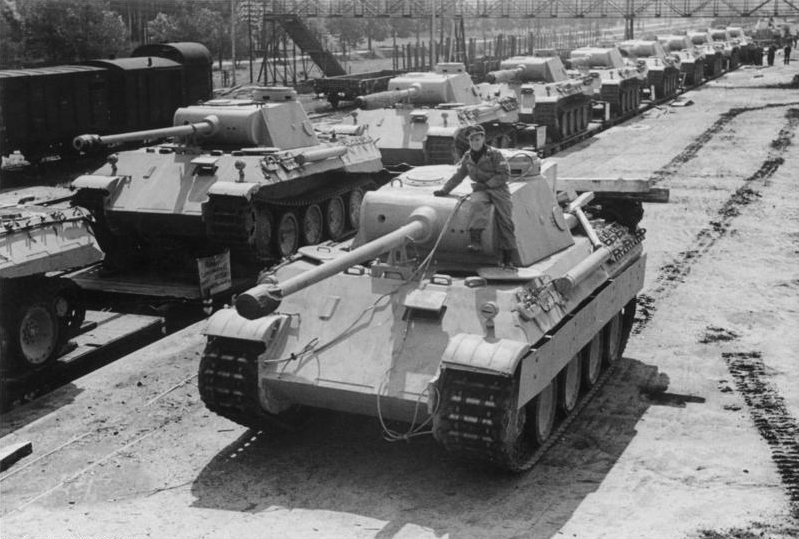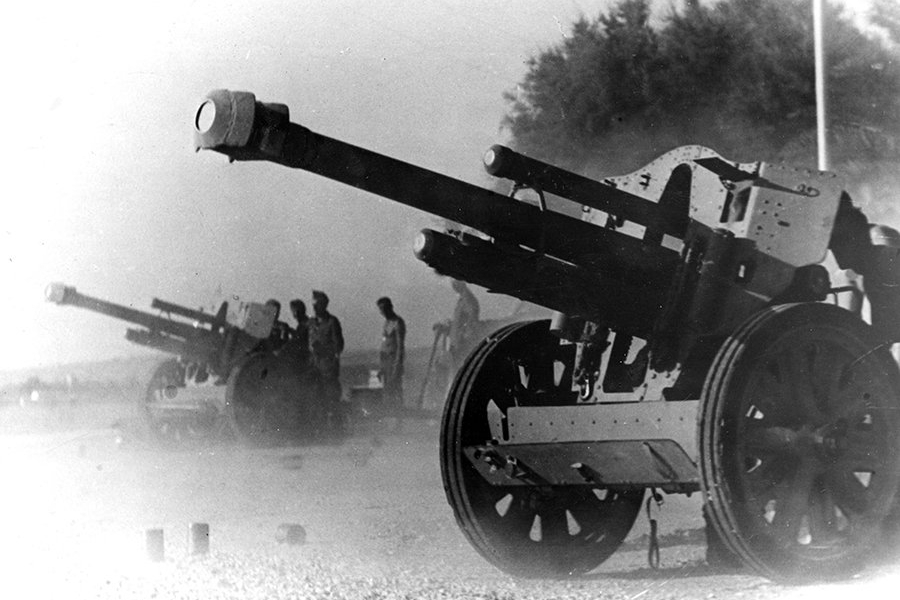Commanders!
Imitation may be the highest form of flattery, but it's not all about nabbing an adversary's tank and using it against them. While this sometimes turns out well for the new owners, such as in the case of the German Panther during World War Two, other times, it can create a real headache—just look at the French B1. With the
 V
V
105 leFH18B2
making a rare appearance in the Premium Shop this week, we're taking a look back at some of the vehicles that traded sides during the Second World War and examining their legacy.
The Many Spots of the Panther
 German Panthers being delivered to the front line, 1943.
German Panthers being delivered to the front line, 1943. There's one plain and simple motivation for capturing an enemy's vehicle: it's better than yours. Technological advantages can be key in war, and from the history of World War II, we've seen how captured enemy tanks can sometimes turn the tide for forces lacking armor or firepower. In the latter years of the conflict, the
 VII
VII
Panther
was considered one of the strongest machines on the battlefront, so it's no surprise that several countries assimilated it into their arsenals when given the opportunity.
In October 1944, Canadian forces captured an intact Panther in Italy and renamed it "The Deserter." It was used during multiple assaults, including one against a German observation post, before it was pulled from battle to be studied. A few months later, in January 1945, the British also found an abandoned Panther in a barn and used it to push through Dutch villages. Christened "Cuckoo," this Panther wore British khaki green and fought during the battle of Geijsteren Castle and Operation Blackcock.
 German Panthers being delivered to the front line, 1943.
German Panthers being delivered to the front line, 1943.  British soldiers with their captured Panther, Cuckoo.
British soldiers with their captured Panther, Cuckoo. Left: Capture of Pudel in Okopowa Street, Warsaw, 1944. Right: British soldiers with their captured Panther, Cuckoo.
Poland also managed to capture a few of their own Panthers. In particular, the
 VI
VI
Pudel
turned out to be a key player in the insurrection of Warsaw in August 1944. The vehicle was stolen by the Polish Home Army, who used it tremendously in their capital city, first to destroy several German machine guns nests, and then by moving it against the Gęsiówka concentration camp, where the tank freed no less than 340 prisoners. After this heroic endeavor, the Pudel served in the streets of Warsaw, where it admirably held its ground against German forces.
 Bretagne Panther, Tankfest 2019
Bretagne Panther, Tankfest 2019Further west, in early 1945, the French 1st Mobile Reconnaissance Group received word of German armor abandoned in Normandy, leading Captain Guy Besnier, a former tank commander, to send a group of mechanics to recover the vehicles. It wasn't a pleasant job—the recovery of some vehicles required removing their dead crew—but the group managed to claim a total of 17 vehicles: a Tiger 1, a Jagdpanzer, two Panthers (Ausf. A and G), 2 StuGs, and 11 Panzer IVs. Most received new paint jobs and were renamed after French regions and towns, such as the
 VI
VI
Bretagne Panther
, which would never fire a shot in combat. Instead it was used to train the next generation of French tankers.
French Tanks Don't Speak German
 Char B1
Char B1However, not every capture is a coup. The Panther's reliability was far from perfect, often breaking because of technical issues in the hands of both German and Allied crews. Nevertheless, it managed to find a use. The
 IV
IV
B1
, on the other hand, proved very troublesome.
Massive and heavily armored, this French tank was a terrifying opponent at the beginning of World War II. In one instance, it survived 140 direct hits and single handedly took out 13 Panzers. In the end, however, it was defeated by the speed and mobility of the German tanks operating under the Blitzkrieg doctrine. As a result, German troops occupying France claimed dozens of B1 tanks but had no idea how to make use of them.
Transforming these metal beasts, which were given the designation
 IV
IV
Pz.Kpfw. B2 740 (f)
, wasn't as simple as working on light or cavalry tanks, even with the help of two occupied Renault and AMX factories. Unlike with the Czechoslovakian tanks, and especially the
 III
III
Pz.Kpfw. 38 (t)
, the German weapon systems weren't compatible with French standards. After several battles, the German command decided to turn the B2 into a flamethrower tank.
Germany already had experience with these kinds of conversions, having converted the Pz.Kpfw. II Ausf. D and Ausf. E. However, despite this knowledge, the B2 was still capricious and failed to meet the Wehrmacht's needs. Then, the Germans decided to combine the B1's massive hull with the heavy 10.5 cm leFH 18 howitzer, creating the
 V
V
105 leFH18B2
. This same gun had proven reliable and maneuverable on the
 III
III
Wespe
, but the B2 still refused to obey its new masters.
Interactive image. Slide between the two images to compare the standalone 10.5 cm leFH 18 howitzer and the gun's integration with the B1 tank as the 105 leFH18B2.


Thankfully for the Germans, the British RAF happily relieved of their issue by turning the B2 factories into ruins during a bombing raid and preventing both their repair and any further conversion with French parts. The remaining tanks were organized into different brigades, and some fought against the Normandy Landings. When the Free France forces crossed paths with some B2s, they typically captured and reused these vehicles in proper units—a decision as symbolic as it was strategic.
Know Your Enemy
Since entering captured tanks into service offered somewhat mixed results, understandably, some forces chose to just study their new vehicles. One of the most iconic examples shows how effective this strategy could be:
 VI
VI
Tiger 131
.
Captured after a short-lived career in North Africa, this famous vehicle was repaired by British crews, who used spare parts from another wounded Tiger to bring it back to life. Soon after, the machine was sent back to the UK for careful inspection, and a technical description of it was compiled. The document was 250 pages long, and it helped the British command design the
 VI
VI
Sherman Firefly
.

Annotations on a picture of a King Tiger
This kind of study often had a huge impact on the war, as was the case with the
 VIII
VIII
Tiger II
, or King Tiger, which was shrouded in mystery when the British first encountered it in France in July 1944. Eventually, the Allies managed to get their hands on a fresh Tiger II, and after a complete study, they claimed it was the strongest German tank at the time. This analysis also revealed the immense strength of the front armor. It was clear that several well-known techniques for defeating Panthers and Tigers wouldn't work on this beast. In the end, the intelligence gained from studying the enemy aided the Allies in their victory.

Thanks to research and testimonials from engagements with vehicles, we've learned so much about the strengths and weaknesses of these incredible tanks. If you want to know the secrets to taking down the Tiger I and learn more about its imposing features, check out our examination of the battlefield icon here.
Perhaps you're also interested in the nuances of working with tanks, especially in a workshop. If so, take a look at our insightful interview with The Tank Museum's workshop team.
Roll Out!
